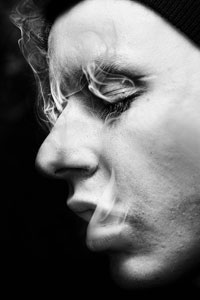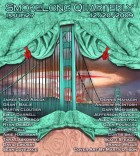This is a very understated piece. For example, it’s not mentioned which distances he ran, for which school, or what kind of dancer his girl friend is. This makes the few specific details all the more intriguing: The fact that the statue was of a Civil War hero, for instance (and not a random heap of metal), the humid night of his accident, the peach blossoms. I wonder whether these are deliberate choices. And are there connections between these choices and the theme of running?
I wanted the piece to be as sparse as possible—yet I wanted it to create a vivid picture. So I went with more details and a very skeletal frame. The aspect of the setting—the summer night, the smell, the statue—all of that came from my visits to a friend’s house in Richmond. Those details always hung with me, and they worked their way into this piece.
Reading this story more closely, I found that the last paragraph contains such peaceful, gorgeous images: his soul at rest, the track gliding beneath his feet, the thick scent of blossoms. Yet there is also an overwhelming sense of loss. Trying to understand the runner, I wondered which feeling is stronger in him: Happiness because he has these memories (and he can still appreciate the beauty of the dance in a way others might not), or sadness at what he has lost? Would he be happier if he never had run?
I think he’s happy to have known such a time—and happy to be reminded of it through his girlfriend’s dancing. Of course that comes with a bit of melancholy, but most happiness has an element of that.
For some reason, I assumed he met his girlfriend after his accident. And I would go even further in assuming that he has never told her about his past as a runner. She is dancing for him, but he is really watching himself. Is he really that much of a narcissist? Or is their story (as a couple) different?
To be honest, I never thought of anything in their relationship beyond the moment of the story. To me, the before and after for these two isn’t as important as the now.
As a fan of running, I have to ask: Why did you make him a runner, as opposed to, say, a dancer? Is it the solitary aspect of this particular sport? Or were you more interested in the transient nature of athletic/ physical gifts in general? Could he also have been a swimmer, for instance, or a football player?
I’ve been a runner for many years—not a great one by any means, but I’ve put in my miles. I was attracted to the solitary nature of running—the experience only he could know and understand. I think that makes both the memory and the sense of loss more compelling.



 The core workshop of SmokeLong Fitness is all in writing, so you can take part from anywhere at anytime. We are excited about creating a supportive, consistent and structured environment for flash writers to work on their craft in a community. We are thrilled and proud to say that our workshop participants have won, placed, or been listed in every major flash competition. Community works.
The core workshop of SmokeLong Fitness is all in writing, so you can take part from anywhere at anytime. We are excited about creating a supportive, consistent and structured environment for flash writers to work on their craft in a community. We are thrilled and proud to say that our workshop participants have won, placed, or been listed in every major flash competition. Community works.